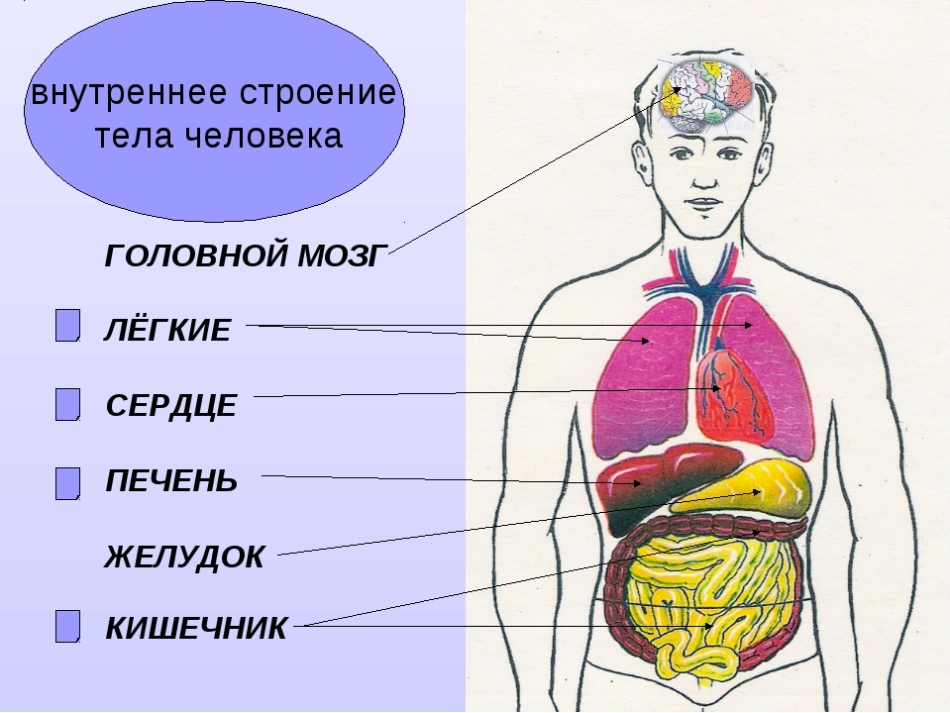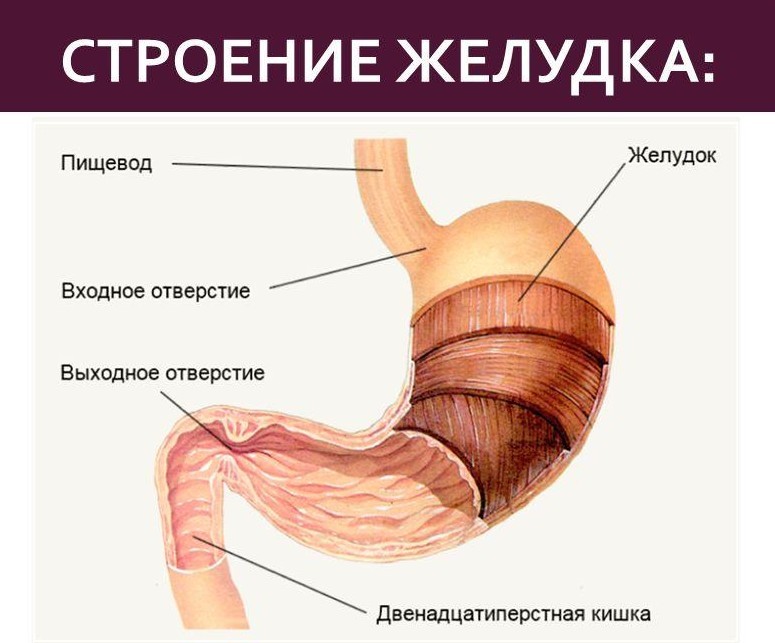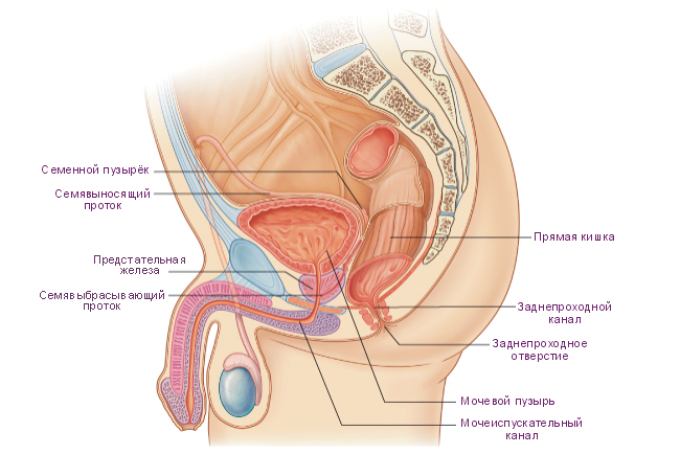The structure of the human body is unique. The coordinated work of each organ provides vital activity. Each area consists of a certain set of organs.
Content
- Human internal structure: photo with inscriptions
- Video: “Human anatomy. Where is what is located? "
- The brain is an important human organ
- Video: "The brain, structure and functions"
- What organs are inside the chest?
- Video: "Pectoral organs"
- What organs are included in the abdominal cavity?
- How are the pelvic organs located?
- Video: “Human anatomy. Abdominal organs "
Human internal structure: photo with inscriptions
Man is the most complex organism on our planet, which is able to perform several functions at the same time. All organs have their duties and carry out work hard: the heart shakes blood, spreading it through the body, the lungs process oxygen into carbon dioxide, and the brain processes mental processes, others respond to the movement of a person and his vital activity.
Anatomy is a science that studies the structure of man. It distinguishes the external (what can be observed visually) and the internal (hidden from the eyes) structure of a person.

External structure - These are parts of the body that are open to a person’s gaze and they can easily be listed:
- head - upper round body
- neck - part of the body connecting the head and torso
- breast - front of the body
- back - back of the body
- the body is a human body
- upper limbs - hands
- lower limbs - legs
The internal structure of a person -it consists of a number of internal organs that are located inside a person and have their own functions. The internally structure of a person consists of the main more important organs:
- brain
- lungs
- heart
- liver
- stomach
- intestines

A more detailed listing of the internal structure includes blood vessels, glands and other vital organs.



You can notice that the structure of the human body is similar to the structure of representatives of the animal world. This fact is explained by the fact that from the theory of evolution, a person came from mammals.
A person developed together with animals and not rarely scientists notice his similarity to some representatives of the animal world at the cellular and genetic level.
Cell -the elementary particle of the human body. The accumulation of cells forms the cloth,actually, of which the internal organs of man consist.
All human organs are combined into systems that are balanced to work to ensure the complete life of the body. The human body consists of such important systems:
- Musculoskeletal system- It provides a person with movement and supports the body in the necessary position. It consists of a skeleton, muscles, ligaments and joints
- Digestive system -the most complex system in the human body, it is responsible for the digestive process, providing a person with energy for life
- Respiratory system -it consists of light and respiratory tract, which are created in order to process oxygen in a carbon dioxide, saturating with oxygen blood
- The cardiovascular system -has the most important transport function, providing blood with the whole human body
- Nervous system -regulates all the functions of the body, consists of two types of brain: brain and spinal, as well as nerve cells and nerve endings
- Endocrine systemregulates nervous and biological processes in the body
- Sexual and urinary system -a number of organs that differ in the structure in men and women. Have important functions: reproductive and excretory
- Pokroval system -provides protection of internal organs from the external environment, represented by the skin
Video: “Human anatomy. Where is what is located? "
The brain is an important human organ
The brain provides a person with mental activity, distinguishing him from other living organisms. In fact, it is a mass of nervous tissue. It consists of two large hemispheres, a varolium bridge and cerebellum.

- Large hemispheresnecessary in order to control all mental processes and provide a person with conscious management of all movements
- In the back of the brain is cerebellum.It is thanks to him that a person is able to control the balance of the whole body. The cerebellum controls muscle reflexes. Even such an important action as to pull the hand from a hot surface so as not to damage the skin - controls the cerebellum
- Ponslies below the cerebellum at the base of the skull. Its function is very simple - to receive nerve impulses and transfer them
- Another bridge is oblong, it is slightly lower and connects to the spinal cord. Its function is to accept and transmit signals from other departments
Video: "The brain, structure and functions"
What organs are inside the chest?
There are several vital organs in the chest cavity:
- lungs
- heart
- bronchi
- trachea
- esophagus
- diaphragm
- bitter iron

The chest is a complex structure, mainly filled with light. It contains the most important muscle organ - the heart and large blood vessels. Diaphragm - A wide flat muscle that separates the chest from the abdominal cavity.
Heart -between the two lungs, this canvas-mummer is located in the chest. Its dimensions are not large enough and it does not exceed the volume of the fist. The task of the organ is simple but important: to escalate blood into the arteries and take venous blood.
The heart is located quite interestingly - oblique presentation. A wide part of the organ is directed back to the right, and narrow to the left down.

- The main vessels come from the base of the heart (wide part). The heart should regularly escalate and treat blood, spreading fresh blood to the entire body
- The movement of this body is provided by two halves: left and right ventricle
- The left ventricle of the heart is greater than the right
- The pericardium is the fabric covering this muscle organ. The outer part of the pericardium is connected to the blood vessels, the internal grows to the heart
Lungs -the most voluminous pair organism in the human body. This organ occupies most of the chest. These organs are exactly the same, but it is worth noting that they have different functions and structure.

As can be seen in the picture, the right lung has three shares, in comparison with the left, which has only two. Also, the left lung is bending on the left side. The task of the lungs to process oxygen into carbon dioxide and saturate the blood with oxygen.
Trachea -it occupies the position between the bronchi and the larynx. The trachea is the cartilage half rings and connecting ligaments, as well as muscle tissue on the back wall, covered with mucus. To the bottom, the trachea is divided into two bronch.These bronchi are sent to the left and right lung. In fact, the bronchus is the most common continuation of the trachea. The light inside consists of many branches of the bronchus. Bronch functions:
- airphone - conducting air through the light
- protective - cleansing function

The esophagus -a long organ that originates in the larynx and passes through diaphragm(muscle organ), connecting to the stomach. The esophagus has ring muscles that provide the movement of food to the stomach.

Bitter iron -gland, which found its place under the sternum. It can be considered part of the human immune system.

Video: "Pectoral organs"
What organs are included in the abdominal cavity?
The abdominal organs are the organs of the digestive tract, as well as the pancreas along with the liver and kidneys. There are also: spleen, kidneys, stomach and genitals. The abdominal organs are covered with peritoneum.

Stomach -one of the main organs of the digestive system. In fact, it is a continuation of the esophagus, separated by a valve that covers the entrance to the stomach.
The stomach has the shape of a bag. Its walls are able to produce special mucus (juice), the enzymes of which will split food.

- Intestines -the longest and volume part of the gastric tract. The intestines begin immediately after the outlet of the stomach. It is built in the shape of a loop and ends with an output. The intestines have large, small intestines and rectum
- The small intestine (duodenum and iliac) goes into a thick, thick into a straight line
- The task of the intestine is to digest and remove the remnants of food from the body

Liver -the largest iron in the human body. She also participates in the digestive process. Its task is to ensure metabolism, participate in the process of blood circulation.
It is located right under the diaphragm and divide into two shares. Vienna connects the liver with the duodenum. The liver is closely connected and functions with the gallbladder.

Kidneys -the paired organ located in the lumbar region. They perform an important chemical function - the regulation of homeostasis and urination.
They have the kidneys of the beans and are part of the urinary organs. There are right above the kidneys the adrenal glands.

The bladder -a kind of bag for collecting urine. It is immediately behind the pubic bone in the inguinal region.

Spleen -it is located above the diaphragm. Has a number of important functions:
- micperity
- body protection
The spleen has the ability to change in size depending on blood accumulation.

How are the pelvic organs located?
These organs are located in a space limited to the pelvic bone. It is worth noting that female and male pelvic organs vary.
- REAME Testament -a similar organ in both men and women. This is the final part of the intestine. Digesting products are removed through it. The rectum should be about fifteen centimeters in length
- Bladderit varies in the location, female and male placement in the cavity. In women, he comes into contact with the walls of the vagina, as well as the uterus, in men he adjoins the seed bubbles and streams, that they bring the seed, as well as to the rectum

- Vagina -a hollow tubular organ that is located from the sexual slit to the uterus. It has a length of about 10 centimeters and adjacent to the cervix, the organ passes through the urine-floor diaphragm
- Uterus -organ consisting of muscles. It has the shape of a pear and is located behind the bladder, but in front of the rectum. The organ is customary to divide into: bottom, body and neck. Performs a detailed function
- Ovary -the pair organ of the egg -shaped shape. This is female gland that produces hormones. In them, eggs ripen. The ovary is connected to the uterus of the phallopian pipes

- Seven Bubble -it is located behind the bladder and has the form of a paired organ. This is a secretory male organ. Its size is about five centimeters in diameter. It is a bubble combined with each other. Organ function - produce seed for fertilization
- Prostate - An organ consisting of muscles and glands. It is located directly on the urine-floor diaphragm. The base of the organ is the urinary and seed channel








A very useful article. Thanks
thank you for the fact that there is such a site
A wand is a helping out, thanks to everyone who has put a hand in helping a person, which means that a person will love his body enough to cease to negatively relate to his whims.
Everything is very accessible, understandable and autumn in detail, thanks for the article